SSYongala
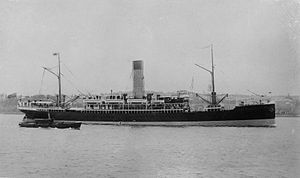 Yongalain port
| |
| History | |
|---|---|
| Name | Yongala |
| Namesake | Yongala, South Australia |
| Owner | |
| Port of registry | Port Adelaide |
| Builder | Armstrong, Whitworth & Co,Low Walker |
| Cost | £102,000 |
| Yard number | 736 |
| Launched | 29 April 1903 |
| Completed | October 1903 |
| Identification |
|
| Fate | Lost with all hands, 23 March 1911 |
| Notes | One of the largest, best-preserved shipwrecks in Queensland |
| General characteristics | |
| Type | Passenger ship |
| Tonnage | 3,664GRT,1,825NRT |
| Length | 350.0 ft (106.7 m) |
| Beam | 45.2 ft (13.8 m) |
| Depth | 27.2 ft (8.3 m) |
| Decks | 2 |
| Installed power | 690NHP |
| Propulsion |
|
| Speed | 16 knots (30 km/h) |
| Capacity |
|
| Crew | 72 |
| Notes | sister ship:Grantala |
SSYongalawas apassengersteamshipthat was built in England in 1903 for theAdelaide Steamship Company.She sank in acycloneoff the coast ofQueenslandin 1911, with the loss of all 122 passengers and crew aboard.
Her wreck offCape Bowling Greenwas found in 1958. It is now a popularwreck divingsite, protected by the CommonwealthUnderwater Cultural Heritage Act 2018.
Yongalawas thesister shipofGrantala,which in 1914 became Australia's onlyhospital shipin theFirst World War.
Building and identification[edit]
In 1903 Sir WGArmstrong, Whitworth & Cobuilt a pair of passenger and cargo steamships at itsLow Walkershipyard atNewcastle upon Tynefor the Adelaide Steamship Co.Yongalawas built as yard number 736, launched on 29 April 1903, and completed that October.[1]She was named after the town ofYongala, South Australia.The name is aNgadjuriword that means "broad water", or "broad wide watering place".[2]Her sister shipGrantalawas yard number 737, launched on 28 May 1903,[3]and completed that December.[4]
Yongala's registered length was 350.0 ft (106.7 m), her beam was 45.2 ft (13.8 m) and her depth was 27.2 ft (8.3 m). Hertonnageswere 3,664GRTand 1,825NRT.She had a singlescrew,driven by a three-cylindertriple expansion enginebuilt by theWallsend Slipway Company.She had five single-ended boilers, which supplied steam to her engine at 180lbf/in2(1,200 kPa). Her furnaces burned about 67 tonnes of coal per day.[citation needed]Her engine was rated at 690NHP[5]and gave her a speed of 16 knots (30 km/h).[6]
Yongalahad accommodation for 110 first class and 130 second class passengers,[6]and holds for about 3,000 tons of cargo.[7]She had electric lighting throughout.[5]She had a direct acting steamwindlassandcapstanon her forecastle head.[citation needed]To handle her cargo she had two steam cranes and seven winches withderricks.[citation needed]A specially arranged steam and hand steering gear was fitted in a house at the after end of the fantail and controlled from the bridge.[citation needed]She had 10,000 cubic feet (283 m3) of refrigerated space: 3,000 cubic feet (85 m3) chilled for vegetables and provisions, and 7,000 cubic feet (200 m3) for frozen meat.[8]
The Adelaide Steamship CoregisteredYongalaatPort Adelaide.HerUKofficial numberwas 118332 and hercode letterswere VGFH.[5][9]
Service history[edit]
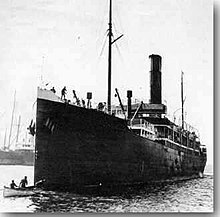
Yongalabegan her delivery voyage fromSouthamptonin England on 9 October 1903.[10]She sustained some damage in heavy weather crossing theBay of Biscay,[7]called atLas PalmasandCape Town,[8]and on 24 November reachedFremantle.[7]When she continued her voyage from Fremantle toAdelaide,it was alleged that she raced theOrient Steam Navigation Companymail shipRMSOrizaba,and thatYongalawon the race.[11]The Adelaide Steamship Company publicly denied that any race took place.[12]On 30 November she reached Port Adelaide, where Adelaide Steamship Co shareholders inspected her.[13]She reachedMelbourneon 3 December[8]and Grafton Wharf[6]inSydneyon 6 December.[14]
In 1905Yongala's regular route linked Fremantle and Sydney via Adelaide and Melbourne. In 1906 her summer route was extended toBrisbane.At 2,700 nautical miles (5,000 km) this was Australia's longest interstate shipping route, andYongalawas the first ship to work it.[citation needed]Each winter from 1907 to 1911 she worked the route between Melbourne andCairnsinstead.[2]
Loss[edit]
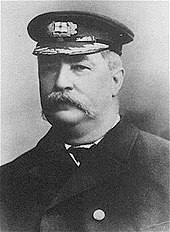
On 14 March 1911Yongalabegan her 99th voyage in Australian waters.[15]HerMasterwasCaptainWilliam Knight. She left Melbourne with 72 passengers, and on 20 March reached Brisbane. There most of her passengers from Melbourne disembarked, and she embarked passengers to continue up the Queensland coast. Also embarked were the racehorse "Moonshine" and aLincoln Redbull. A harbour inspection reportedYongalato be "in excellent trim".[2]
She reachedMackayon the morning of 23 March, and left at 1:40pm that afternoon, bound forTownsville.She was now carrying 29 first class passengers, 19 second class passengers, 72 crew, and 677 tons of cargo.[16]Shortly after she left Mackay, and before she left the sight of land, theFlat Top Islandsignal station received a telegram warning of a tropical cyclone between Townsville and Mackay. The signal station sentflagandwireless telegraphsignals, which prompted several ships to take refuge at Mackay. ButYongaladid not see the flags. TheMarconi Companyhad recently dispatched a wireless telegraph set from England to be installed aboardYongala,but the set had not yet reached Australia.[2]
Five hours afterYongalaleft Mackay, the keeper ofDent Island Lightsaw her enterWhitsunday Passage.This was the last known sighting of her. Thecyclonesank her on the night of 23–24 March, killing everyone aboard.[2]Newspapers at the time counted 120 or 121 people aboard, but the total number is now accepted to be at least 122. The discrepancy arises from young children, servants, and members of ethnic minorities being omitted from official lists.[17]
Aftermath[edit]

WhenYongaladid not reach Townsville on time, at first it was assumed that, like other ships, she had taken shelter from the cyclone. But on 26 March she was listed as "missing". ThePremier of Queensland,Digby Denham,ordered a search for her, in which seven vessels took part. Wreckage started to wash ashore on the Queensland coast betweenHinchinbrook IslandandBowen.The body of the racehorse "Moonshine" was found at Gordon Creek, but no trace was found of any of the passengers or crew. TheQueensland Governmentoffered a £1,000 reward for information enabling the ship to be found. The reward went unclaimed, so it was eventually withdrawn.[2]
It was speculated that either the cyclone had overwhelmedYongala,or she may have grounded on a reef between Flinders Passage and Keeper Reef, or on Nares Rock, or onCape Upstart.[citation needed]
Within days of the ship's loss, "Yongaladistress fund "was set up. Money raised was used to relieve the dependants of those aboard. The fund was closed on 30 September 1914, with the £900 remaining credited to the Queensland Shipwreck Society.[citation needed]
Between 8 and 20 June 1911 the Marine Board of Queensland held an inquiry intoYongala's loss. The Board considered the ship's stability, equipment and seaworthiness, and Captain Knight's abilities as a shipmaster. It found no fault with the condition of the ship, based on design specifications supplied by the Adelaide Steamship Co, along with data fromsea trialsand seven years of uneventful operation. Nor did it find fault with Knight's ability. He was one of Adelaide Steamship Co's most capable men, and had 14 years' service without incident.[2]The Board declared that it had "no desire to indulge in idle speculation", and concluded that "the fate of the Yongala passes beyond human ken into the realms of conjecture, to add one more to the long roll of mysteries of the sea".[16]
Discovery[edit]
In 1943, aminesweeperfouledon what was then thought to be ashoal,11 miles east of Cape Bowling Green. The commander marked on his chart an obstruction at a depth of about 13 fathoms (24 m), on the route of vessels bound for Townsville.[18]

In June 1947, thesurvey vesselHMASLachlaninvestigated the location usingecho soundingandanti-submarineequipment. She found a shoal about 300 feet (91 m) long, at a depth of about 6 fathoms (11 m), surrounded by water 12 to 14 fathoms (22 to 26 m) deep, and concluded that it could be the wreck of a steamship.[18]
In 1958 a local fisherman, Bill Kirkpatrick, found the wreck, and recovered artefacts including asafefrom one of the cabins. The safe contained only black sludge, but part of the safe's serial number was legible: 9825W. In 1961,Chubbin England identified this as the number of the safe that it supplied to Armstrong, Whitworth & Co. in 1903 for the cabin ofYongala'spurser.[2][18]
Wreck site[edit]

Yongala's wreck is at position19°18′15.9″S147°37′31.6″E/ 19.304417°S 147.625444°E,[17]in the central section of theGreat Barrier Reef Marine Park,about 48 nautical miles (89 km) southeast of Townsville and 12 nautical miles (22 km) east of Cape Bowling Green. The wreck is 109 metres (358 ft) long. The bow points on a northerly bearing of 347 degrees, and lists to starboard at an angle of between 60 and 70 degrees. It retains its structural integrity. The depth of water to the sea floor is about 30 metres (98 ft), with the upper parts of the wreck 16 metres (52 ft) below the surface.
The sea floor around the wreck is open and sandy, so the wreck has become an establishedartificial reef,providing a structurally complexhabitatfor diverse marine life. In 1981 themarine biologistLeon Zann sketched the wreck. Itssuperstructureremains intact and much as in his sketch, but a significant buildup of sand around thestarboardside of the vessel has been scoured away, and the ventilators and railings have collapsed.[citation needed]
The wreck is protected by the Commonwealth Underwater Cultural Heritage Act 2018 and is managed via theMuseum of Tropical Queensland,Townsville. The Act prohibitspenetration divingand interference withartefacts.
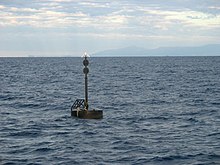
A protected zone encompasses both the wreck, all the seabed within a radius of 797 metres (2,615 feet) from the wreck, and the waters above. Access to the site is via permit only, obtainable from the Maritime Archaeology Section of the Museum of Tropical Queensland.[17]In 2002, to prevent further damage by careless anchoring, severalmooringswere installed, and anchoring within the protected zone was forbidden. The site was also listed on the now-defunctRegister of the National Estate.[19]
Present day[edit]
Yongalais now a major tourist attraction forrecreational divingin Townsville and North Queensland, with more than 10,000 divers visiting the wreck each year.[20]At 110 metres (361 ft) long, she is one of the largest, most intact historic shipwrecks.[21]The site has diverse marine life. A citizen science database using iNaturalist has recorded more than 213 observations of 79 species. The most observed species is theHumphead wrasse,Cheilinus undulatus.[22]An episode of theBBCtelevision documentary seriesGreat Barrier Reeffeatured the wreck's biodiversity.
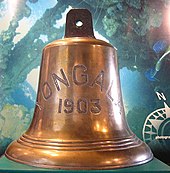
The Maritime Museum of Townsville has an extensive display ofYongalaartefacts and memorabilia, including hership's bell.[2]
Thedeath of Tina Watsonoccurred near the dive site on 22 October 2003. Watson's husband of eleven days was subsequently imprisoned for manslaughter.[citation needed]
The heritage-listedYongala LodgeinNorth Ward,Townsville, is named after the ship. It was built forMatthew Rooney,who died in theYongalashipwreck along with his wife and youngest daughter.[23]
See also[edit]
- List of maritime disasters
- Koombana,a steamship lost in 1912 off Western Australia
- Waratah,a steamship lost in 1909 off South Africa
- Protected areas of Australia– Protected areas in Australia
References[edit]
- ^"Yongala".Tyne Built Ships.Shipping and Shipbuilding Research Trust.Archivedfrom the original on 1 May 2023.Retrieved1 May2023.
- ^abcdefghi"Yongala Artefacts".Maritime Museum of Townsville.Archivedfrom the original on 30 May 2024.Retrieved29 September2019.
- ^"Grantala".Tyne Built Ships.Shipping and Shipbuilding Research Trust.Archivedfrom the original on 28 January 2022.Retrieved1 May2023.
- ^Lloyd's Register1904,GRA.
- ^abcLloyd's Register1904,YIK–YOR.
- ^abc"The new steamer Yongala".Daily Commercial News and Shipping List.7 December 1903. p. 5.Archivedfrom the original on 1 May 2023.Retrieved1 May2023– viaTrove.
- ^abc"Port of Fremantle".The Daily News.24 November 1903. p. 1.Archivedfrom the original on 1 May 2023.Retrieved1 May2023.
- ^abc"The new steamer Yongala".The Age.4 December 1903. p. 4.Archivedfrom the original on 1 May 2023.Retrieved1 May2023– via Trove.
- ^"New inster-state steamer".Daily Commercial News and Shipping List.16 October 1903. p. 4.Archivedfrom the original on 1 May 2023.Retrieved1 May2023– via Trove.
- ^"The Ocean Race".The Daily News.30 November 1903. p. 1.Archivedfrom the original on 1 May 2023.Retrieved1 May2023– via Trove.
- ^Moxon, W (30 November 1903)."The Yongala and the Orizaba".The Daily News.p. 6.Archivedfrom the original on 1 May 2023.Retrieved1 May2023– via Trove.
- ^"The new steamer Yongala".The Advertiser.1 December 1903. p. 4.Archivedfrom the original on 1 May 2023.Retrieved1 May2023– via Trove.
- ^"Oversea movements".Daily Commercial News and Shipping List.8 December 1903. p. 7.Archivedfrom the original on 1 May 2023.Retrieved1 May2023– via Trove.
- ^Hind, Karen (28 February 2011)."Queensland 100 Years Ago - The Sinking of the S. S. Yongala".State Library Of Queensland.Archivedfrom the original on 1 September 2023.Retrieved1 September2023.
- ^ab"Yongala Disaster".The Telegraph.21 June 1911. p. 15 – via Trove.
- ^abc"View Shipwreck – Yongala".Australasian Underwater Cultural Heritage Database.Australian Government.Archivedfrom the original on 1 May 2023.Retrieved20 August2021.
- ^abcHolthouse 1971,pp. 59–66.
- ^"SS Yongala Shipwreck, Cape Bowling Green via Ayr, QLD, Australia (Place ID 14835 )".Australian Heritage Database.Australian Government.28 September 1982.Retrieved20 August2012.
- ^Cussons, David (3 May 2005)."Safeguarding the wreck the SSYongala".ABC North Queensland. Archived fromthe originalon 28 May 2006.Retrieved8 March2008.
- ^"SSYongalaDive Site ".Things to See & Do.Tourism Queensland. Archived fromthe originalon 28 June 2008.Retrieved9 March2008.
- ^"Citizen science at Yongala Shipwreck".Archivedfrom the original on 3 July 2022.Retrieved22 April2022.
- ^"Yongala Lodge (entry 600878 )".Queensland Heritage Register.Queensland Heritage Council.Retrieved1 August2014.
Bibliography[edit]
- Gleeson, Max (1987).Townsville's Titanic.Sydney: Turton & Armstrong.ISBN0-908031-31-9.OCLC27579405.
- Holthouse, Hector (1971). "Yongala Vanishes".Cyclone: A Centory of Cyclonic Destruction.Adelaide: Rigby.ISBN0-85179-290-1.OCLC251985.
- Lloyd's Register of British and Foreign Shipping.Vol. I.–Steamers. London: Lloyd's Register. 1904 – viaInternet Archive.
- Mercantile Navy List.London. 1904 – via Crew List Index Project.
{{cite book}}:CS1 maint: location missing publisher (link)
External links[edit]
- "SS Yongala Fantastic wreck of a passenger ship in front of Townsville and Ayr".Pro-Taucher Tauchplätze weltweit.
- "The Ships Company – Officers, Crew and Passengers".Grey River Argus.29 March 1911. p. 6.
- Sumner, John (25 April 2013)."SS Yongala".Ship Wreck Bells.
- "Ben Cropp's This Rugged Coast: The Coral Sea".RecallTV.
- 1903 ships
- Australian Shipwrecks with protected zone
- Iron and steel steamships of Australia
- March 1911 events
- Maritime incidents in 1911
- North Queensland
- Passenger ships of Australia
- Queensland places listed on the defunct Register of the National Estate
- Ships built by Armstrong Whitworth
- Ships built on the River Tyne
- Ships lost with all hands
- Shipwrecks in the Coral Sea
- Shipwrecks of Queensland
- Steamships of Australia
- Underwater diving sites in Australia
